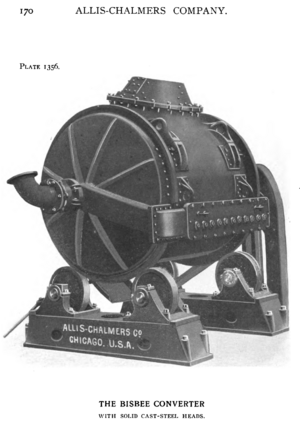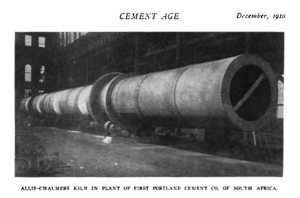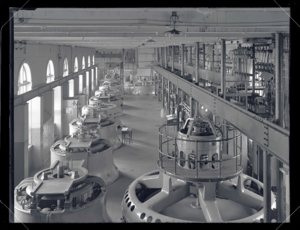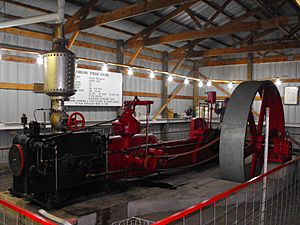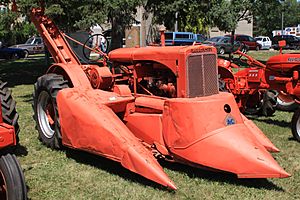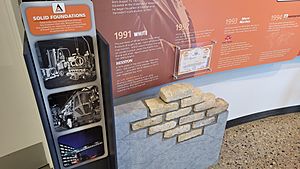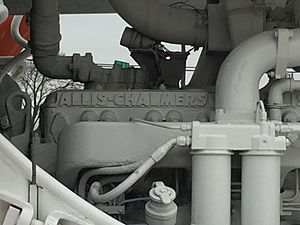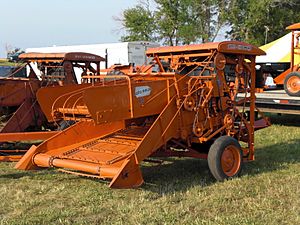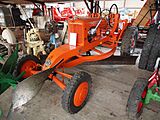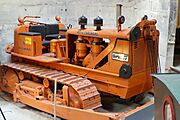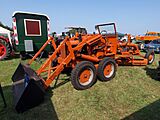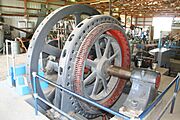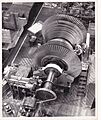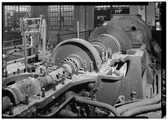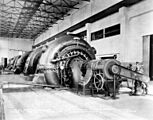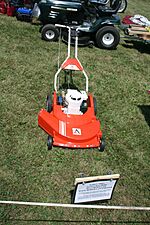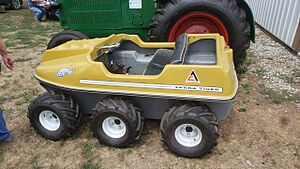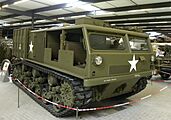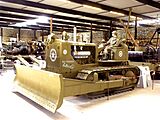Allis-Chalmers facts for kids
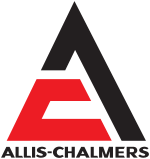 |
|
| Industry | Industrial machinery, grain-milling machinery, power plant equipment, mining equipment, agricultural machinery, heavy equipment (construction) |
|---|---|
| Successor | AGCO, Allis-Chalmers Energy |
| Founded | 1901, West Allis, Wisconsin |
| Defunct | 1999 |
| Headquarters | U.S. based, global exports |
| Products | Generators, engine-generators, tractors, threshers, combines, farm implements, bulldozers, milling machinery, others |
Allis-Chalmers was an American company that made many different kinds of machines. They built equipment for farms, construction sites, power plants, and factories. This included machines for flour mills, sawmills, textile factories, steel mills, and mines.
The first Allis-Chalmers Company started in 1901. It was formed by combining four smaller companies that made things like steam engines, mining equipment, and machines for crushing rocks. In 1912, the company changed its name to Allis-Chalmers Manufacturing Company. For the next 70 years, their industrial machines were used in countless factories and mines around the world. Many people also knew Allis-Chalmers for their bright orange tractors and silver combine harvesters used on farms.
In the 1980s and 1990s, the company began to sell off its different parts. Eventually, it stopped existing as it once did. Today, its main successors are Allis-Chalmers Energy and AGCO.
Contents
- A Look at Allis-Chalmers History
- How Allis-Chalmers Started
- The Early Years: Before 1901
- Growing Stronger: 1901–1911
- New Directions: 1912-1919
- The Roaring Twenties: 1920s Growth
- The Great Depression and Beyond: 1930s
- World War II and After: 1940s
- New Power and Acquisitions: 1950s
- Changes and Joint Ventures: 1960s and 1970s
- Selling Off Divisions: 1980s and 1990s
- The Brand Lives On: 2000 to Present
- Former Locations
- Agricultural Machinery
- Industrial and Construction Equipment
- Power Plant and Industrial Machines
- Lawn and Outdoor Equipment
- Military Machinery
- Allis-Chalmers Energy
- See also
A Look at Allis-Chalmers History
How Allis-Chalmers Started
Allis-Chalmers grew by bringing together the ideas and inventions of several smaller companies. These companies all had a background in working with metal and building machines. They joined forces to become a bigger, stronger company.
One expert said that Allis-Chalmers was like a "conglomerate" before that word was even popular. A conglomerate is a large company made of many different types of businesses. Even though Allis-Chalmers focused on machinery, it made many different kinds of machines for various industries.
The Early Years: Before 1901
Edward P. Allis was a smart businessman. In 1860, he bought a struggling company in Milwaukee, Wisconsin, that made equipment for flour mills. Under his leadership, the company grew quickly. It started making steam engines and other mill equipment just as many sawmills and flour mills were switching to steam power. Even after some financial trouble, Edward P. Allis Company became one of America's largest builders of steam engines by 1900.
Thomas Chalmers, an immigrant from Scotland, started the Fraser & Chalmers company in 1872. They made mining machinery, boilers, and pumps. By 1890, this company was one of the world's largest makers of mining equipment. Another related company, the Gates Iron Works, became known for making machines that crushed rocks and cement.
The Dickson family, also Scottish immigrants, started a machine shop in Scranton, Pennsylvania, in 1852. By 1900, their company, the Dickson Manufacturing Company, built boilers, steam engines, and locomotives.
By 1901, the leaders of these companies decided to merge. They formed the Allis-Chalmers Company. They bought the industrial engine part of Dickson's business.
Growing Stronger: 1901–1911
The new Allis-Chalmers company was led by Charles Allis and William J. Chalmers. Soon after the merger, a new factory was built west of Milwaukee. This area was later named West Allis, Wisconsin, after the company.
Allis-Chalmers now offered a huge range of equipment. This included machines for processing ores, like blast furnaces and crushers. They also made different kinds of mills, such as ball mills and roller mills. The company also provided services like helping mining companies design their plants and train their workers.
In 1903, Allis-Chalmers bought the Bullock Electric Company. This added steam turbines to Allis-Chalmers's power plant equipment business.
New Directions: 1912-1919
By 1912, Allis-Chalmers was having financial problems. It was reorganized and renamed the Allis-Chalmers Manufacturing Company. Otto Falk, a former general, was put in charge to fix things. Falk wanted to create new products and find new markets. He saw a big opportunity in mechanized farming, which was growing fast in America.
Allis-Chalmers developed its first farm tractors between 1914 and 1919. These included models like the 10-18, the Model 6-12, and the Model 15-30. The company also expanded its line of farm tools.
The Roaring Twenties: 1920s Growth
The 1920s were a time of growth for many businesses, and farming continued to become more mechanized. Allis-Chalmers introduced more tractors, such as the 18-30, 12-20, 15-25, and the United tractor/Model U.
A famous inventor, Nikola Tesla, even worked for Allis-Chalmers in Milwaukee from 1919 to 1922.
In 1926, Harry Merritt joined Allis-Chalmers to lead its tractor business. He is credited with turning the struggling farm equipment division into a major success for the company.
Also in 1926, Allis-Chalmers bought Nordyke Marmon & Company, which made flour-milling equipment. In 1927, they acquired Pittsburgh Transformer Company, a maker of electrical transformers.
In 1928, Allis-Chalmers bought Monarch Tractor Company, adding crawler tractors (like bulldozers) to their products. In 1929, they acquired La Crosse Plow Works, which gave them more farm tools.
A fun fact: In 1929, Harry Merritt was in California and saw the bright orange California poppy flowers. He thought bright colors would be great for marketing farm equipment. He decided to paint Allis-Chalmers tractors "Persian Orange," a color that looked very similar to the poppies. This started the tradition of orange Allis-Chalmers tractors! Other companies soon followed with their own bright colors.
The Great Depression and Beyond: 1930s
Even during the Great Depression in the 1930s, Allis-Chalmers did well because there was still a demand for its machines.
In 1931, the company bought Advance-Rumely. This was mainly to gain their network of 24 branch offices and 2,500 dealers, which greatly boosted Allis-Chalmers's sales power for farm equipment.
In 1932, Allis-Chalmers worked with Firestone to put rubber tires on tractors. This was a big deal! It made tractors more efficient and saved fuel. Within just five years, rubber tires were on about half of all new tractors sold. Also in 1932, Allis-Chalmers acquired Ryan Manufacturing Company, adding graders to its construction equipment line.
In 1933, Allis-Chalmers introduced its Model WC, a popular row-crop tractor that became its best-selling tractor ever. In 1937, the lighter and more affordable Model B also became a top seller. Their All-Crop Harvester was a leading machine for harvesting crops.
World War II and After: 1940s
During World War II, Allis-Chalmers became very busy making equipment for the war effort. They built machinery for naval ships, such as steam engines, steam turbines, and generators. They also made artillery tractors and other vehicles for the army. Allis-Chalmers was also involved in the Manhattan Project, helping to build equipment for processing uranium.
Right after the war, in 1945–1946, Allis-Chalmers faced a long 11-month labor strike. Some believe the company never fully recovered from this, as it gave competitors a chance to gain market share.
In 1948, the popular Model WC tractor was improved and became the Model WD. This model was a big step forward for the company. It had a special power take-off system and power-adjust rear wheels, which became a standard in the industry. Nearly 150,000 of these tractors were made until 1953.
New Power and Acquisitions: 1950s
The 1950s saw a demand for more powerful farm tractors and better hydraulic and electrical systems. It was also a time when many machines, from trains to tractors, started using diesel engines. In 1953, Allis-Chalmers bought the Buda Engine Company to get their line of diesel engines.
In 1955, the company acquired Gleaner Manufacturing Company, which was very important for its combine harvester business. Allis-Chalmers was already a leader in pull-type combines, but buying Gleaner made them a leader in self-propelled combines too. Gleaner's profits helped Allis-Chalmers a lot for several years.
In 1957, the Allis-Chalmers D Series of tractors was introduced and became very successful.
Changes and Joint Ventures: 1960s and 1970s
In the 1960s, the D series tractors continued to do well. The D19 tractor was the first in the industry to have a factory-installed turbocharger.
In 1965, Allis-Chalmers bought Simplicity for its lawn and garden equipment. Also that year, a research nuclear reactor called SAFARI-1, built by Allis-Chalmers, started operating.
During the 1960s and 1970s, the farm equipment, construction equipment, and heavy electrical industries became tougher for Allis-Chalmers. While their farm equipment still did reasonably well, the company was often ranked third or fourth behind bigger competitors like John Deere and Caterpillar.
In 1974, Allis-Chalmers's construction equipment business joined forces with Fiat SpA to create a new company called Fiat-Allis. Fiat owned most of this new company.
In 1978, Allis-Chalmers formed another joint venture with Siemens, called Siemens-Allis, to make electrical control equipment.
Selling Off Divisions: 1980s and 1990s
The 1980s were a difficult time for Allis-Chalmers. Due to financial struggles, the company had to sell off many of its major business lines.
In 1983, Allis-Chalmers sold its Simplicity lawn and garden equipment division.
1985 was a year of big changes for Allis-Chalmers:
- The Fiat-Allis construction equipment partnership ended when Fiat bought Allis-Chalmers's remaining share.
- The Allis-Chalmers farm equipment business was sold to K-H-D of Germany. This business was renamed Deutz-Allis.
- The Siemens-Allis electrical controls partnership ended when Siemens bought Allis-Chalmers's remaining share.
In 1988, Allis-Chalmers sold its American Air Filter business, which made filtration products.
In 1990, Deutz-Allis was sold and became Allis-Gleaner Corporation (AGCO). Tractors started being sold under the AGCO-Allis name and were once again painted Persian Orange. The AGCO brand of orange tractors was made until 2011.
In 1998, the last parts of Allis-Chalmers's manufacturing businesses were sold. In January 1999, the company officially closed its offices in Milwaukee. The remaining service businesses became Allis-Chalmers Energy in Houston, Texas.
The Brand Lives On: 2000 to Present
In August 2008, Briggs & Stratton announced that they would sell lawn tractors using the Allis-Chalmers brand name.
Former Locations
| Location | Purpose | Other Facts |
|---|---|---|
| Milwaukee, Wisconsin | Main offices | |
| West Allis, Wisconsin | Wheeled Tractor Plant, Power and Industrial Equipment | |
| Appleton, Wisconsin | Paper Making Machinery Plant | |
| Independence, Missouri | Gleaner Combine Plant | Site came from Gleaner Manufacturing Company |
| La Porte, Indiana | Harvest Equipment and Mower Plant | Site came from Advance-Rumely |
| La Crosse, Wisconsin | Farm Implement Plant | Site came from La Crosse Plow Works |
| Springfield, Illinois | Crawler Tractor, Motor Grader, Bulldozer, and Snow plow Plant | Site came from the Monarch Tractor Company |
| Harvey, Illinois | Fork Lift Truck, Diesel, Natural Gas, Butane, and Gasoline Engine Plant | Site came from the Buda Engine acquisition |
| Norwood, Ohio | Pumps and Motors | Purchased by Siemens Corporation in 1985 and still operating |
| York, Pennsylvania | Hydraulic Turbines and Valves | Now owned by Voith and still operating |
Agricultural Machinery
Allis-Chalmers offered a full range of farm machines, from tools for preparing the soil to harvesting crops, and of course, tractors.
Tractor Models
In 1959, a team led by Harry Ihrig built a 15-kilowatt fuel cell tractor for Allis-Chalmers. This was the first vehicle ever powered by a fuel cell! It was shown at state fairs across the U.S. The original Allis-Chalmers fuel cell tractor is now on display at the Smithsonian.
Below are some of the tractor models Allis-Chalmers made, many in their famous orange color.
Balers
Allis-Chalmers introduced its first baler in 1947, called the "Roto-Baler." It was an early version of modern round balers, making smaller bales. Allis-Chalmers also built many models of small square balers.
Combine Harvesters
Allis-Chalmers first developed their "all-crop harvester" in 1933. This was a machine pulled by a tractor to harvest crops. In 1955, Allis-Chalmers acquired the Gleaner Manufacturing Company and its line of self-propelled combine harvesters. This made them a leader in both types of combines.
Industrial and Construction Equipment
The company made many types of machines for moving earth and for construction, including:
- Road graders
- Tracked bulldozers
- Tracked loaders
- Forklifts
- And more!
Power Plant and Industrial Machines
Allis-Chalmers offered a full range of equipment for power plants and industries. This included large turbo generators and electrical switchgear. From the 1920s to the 1960s, their power plant equipment was a strong competitor to giants like General Electric and Westinghouse. Many of their hydro-electric generators and turbines built in the 1920s are still working today!
Allis-Chalmers also made different types of electrical switchgear and transformers. They produced a wide range of ore crushing equipment for the mining industry from the 1930s to the 1960s and beyond.
In 1965, Allis-Chalmers built "Big Allis" (also known as Ravenswood No. 3). This is the biggest generator in New York, located in Queens. It can produce 1000 megawatts of power and is still working today.
Lawn and Outdoor Equipment
In the late 1960s and early 1970s, Allis-Chalmers started making equipment for lawns and outdoor use.
All-Terrain Vehicles
Allis-Chalmers made a line of 6-wheeled Amphibious ATVs called the "Terra Tiger." These vehicles could travel on land and water!
Fuel Cell Golf Carts
In 1965, Allis-Chalmers even built hydrogen-fueled fuel cell golf carts.
Military Machinery
Allis-Chalmers also contributed to military efforts by producing various machines:
- M1 tractor medium model HD7W
- M1 tractor heavy model HD10W
- M4 tractor high-speed 18-ton artillery tractor (made from 1943)
- M6 tractor high-speed 38-ton (artillery tractor)
- M7 snow tractor
- M19 snow trailer, 1-ton
- M50 Ontos – a light anti-tank vehicle (297 units made from 1955 to 1957)
- Steam turbines for U.S. Navy ships, like the USS Coontz.
Allis-Chalmers Energy
Allis-Chalmers Energy was a company based in Houston that provided services and equipment for oil and natural gas exploration. It merged with another company in 2011 and became Archer.
See also
 In Spanish: Allis-Chalmers para niños
In Spanish: Allis-Chalmers para niños
- List of Allis-Chalmers tractors
- List of Allis-Chalmers engines
- AGCO (owns former Deutz-Allis assets)
- CNH Global (owns former Fiat-Allis assets)
- Siemens AG (owns former Siemens-Allis assets)
- Gleaner (harvester)


